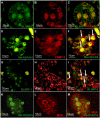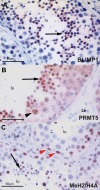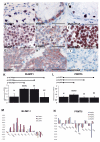Expression of BLIMP1/PRMT5 and concurrent histone H2A/H4 arginine 3 dimethylation in fetal germ cells, CIS/IGCNU and germ cell tumors
- PMID: 18992153
- PMCID: PMC2613889
- DOI: 10.1186/1471-213X-8-106
Expression of BLIMP1/PRMT5 and concurrent histone H2A/H4 arginine 3 dimethylation in fetal germ cells, CIS/IGCNU and germ cell tumors
Abstract
Background: Most testicular germ cell tumors arise from intratubular germ cell neoplasia unclassified (IGCNU, also referred to as carcinoma in situ), which is thought to originate from a transformed primordial germ cell (PGC)/gonocyte, the fetal germ cell. Analyses of the molecular profile of IGCNU and seminoma show similarities to the expression profile of fetal germ cells/gonocytes. In murine PGCs, expression and interaction of Blimp1 and Prmt5 results in arginine 3 dimethylation of histone H2A and H4. This imposes epigenetic modifications leading to transcriptional repression in mouse PGCs enabling them to escape the somatic differentiation program during migration, while expressing markers of pluripotency.
Results: In the present study, we show that BLIMP1 and PRMT5 were expressed and arginine dimethylation of histones H2A and H4 was detected in human male gonocytes at weeks 12-19 of gestation, indicating a role of this mechanism in human fetal germ cell development as well. Moreover, BLIMP1/PRMT5 and histone H2A and H4 arginine 3 dimethylation was present in IGCNU and most seminomas, while downregulated in embryonal carcinoma (EC) and other nonseminomatous tumors.
Conclusion: These data reveal similarities in marker expression and histone modification between murine and human PGCs. Moreover, we speculate that the histone H2A and H4 arginine 3 dimethylation might be the mechanism by which IGCNU and seminoma maintain the undifferentiated state while loss of these histone modifications leads to somatic differentiation observed in nonseminomatous tumors.
Figures





Similar articles
-
Blimp1 associates with Prmt5 and directs histone arginine methylation in mouse germ cells.Nat Cell Biol. 2006 Jun;8(6):623-30. doi: 10.1038/ncb1413. Epub 2006 May 14. Nat Cell Biol. 2006. PMID: 16699504
-
Association of intratubular seminoma and intratubular embryonal carcinoma with invasive testicular germ cell tumors.Am J Surg Pathol. 2007 Jul;31(7):1045-9. doi: 10.1097/PAS.0b013e31802b8712. Am J Surg Pathol. 2007. PMID: 17592271
-
Global DNA hypomethylation in intratubular germ cell neoplasia and seminoma, but not in nonseminomatous male germ cell tumors.Mod Pathol. 2008 Nov;21(11):1337-44. doi: 10.1038/modpathol.2008.127. Epub 2008 Jul 11. Mod Pathol. 2008. PMID: 18622385 Free PMC article.
-
The role of BLIMP1 and its putative downstream target TFAP2C in germ cell development and germ cell tumours.Int J Androl. 2011 Aug;34(4 Pt 2):e152-8; discussion e158-9. doi: 10.1111/j.1365-2605.2011.01167.x. Epub 2011 May 12. Int J Androl. 2011. PMID: 21564135 Review.
-
Epigenetic features of testicular germ cell tumours in relation to epigenetic characteristics of foetal germ cells.Int J Dev Biol. 2013;57(2-4):309-17. doi: 10.1387/ijdb.130142ka. Int J Dev Biol. 2013. PMID: 23784842 Review.
Cited by
-
Insights into female germ cell biology: from in vivo development to in vitro derivations.Asian J Androl. 2015 May-Jun;17(3):415-20. doi: 10.4103/1008-682X.148077. Asian J Androl. 2015. PMID: 25652637 Free PMC article. Review.
-
Germ Cell Derivation from Pluripotent Stem Cells for Understanding In Vitro Gametogenesis.Cells. 2021 Jul 26;10(8):1889. doi: 10.3390/cells10081889. Cells. 2021. PMID: 34440657 Free PMC article. Review.
-
Characterization of the Epigenetic Changes During Human Gonadal Primordial Germ Cells Reprogramming.Stem Cells. 2016 Sep;34(9):2418-28. doi: 10.1002/stem.2422. Epub 2016 Jun 30. Stem Cells. 2016. PMID: 27300161 Free PMC article.
-
Epigenetic drug screening for trophoblast syncytialization reveals a novel role for MLL1 in regulating fetoplacental growth.BMC Med. 2024 Feb 5;22(1):57. doi: 10.1186/s12916-024-03264-8. BMC Med. 2024. PMID: 38317232 Free PMC article.
-
Pluripotent stem cells: origin, maintenance and induction.Stem Cell Rev Rep. 2010 Dec;6(4):633-49. doi: 10.1007/s12015-010-9170-1. Stem Cell Rev Rep. 2010. PMID: 20669057 Review.
References
-
- Lee F, Hamid R, Arya M, Patel HR. Testicular cancer: current update and controversies. Hosp Med. 2002;63:615–20. - PubMed
Publication types
MeSH terms
Substances
LinkOut - more resources
Full Text Sources
Other Literature Sources

